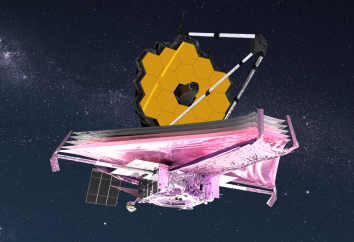
Artist conception of the James Webb Space Telescope. Credit: NASA GSFC/CIL/Adriana Manrique Gutierrez.
7 April 2025
In March, the Space Telescope and Science Institute announced the selection of 274 programs for the fourth year of observations on its James Webb Space Telescope (JWST). This includes approximately 8,500 hours of observing time. Of that, a whopping 10 percent (over 800 hours) was awarded to programs led or co-led by astronomers at The University of Texas at Austin.
JWST is the most powerful telescope currently available to astronomers. It is particularly adept at studying dim and obscured objects that other telescopes can’t see, and objects present in the very early universe that other telescopes can’t reach. Not surprisingly, getting observation time is very competitive. For the coming year of observations, called “Cycle 4,” the JWST team received 2,377 proposals.
“Around thirty percent of the proposals we submitted were accepted,” said Karl Gebhardt, chair of UT Austin’s Department of Astronomy. “To put that number in perspective: overall, JWST only accepted ten percent of the proposals it received. That success rate is a testament to the talent we have here at UT Astronomy and the breadth of topics we study.”
“Getting any time is extremely difficult,” added Steve Finkelstein, director of UT Astronomy’s Cosmic Frontier Center (CFC), which studies the early universe and whose members will be leading or co-leading nine of the selected proposals. “For a single institution to be involved in research receiving so much of JWST’s time is an amazing accomplishment!”
Hubble Research Fellow Seiji Fujimoto is among those with a chosen proposal. At 293 hours spread across two years, his is the second largest program ever awarded by JWST. Fujimoto will use a technique called gravitational lensing to find the universe’s earliest galaxies, stars, and black holes. Gravitational lensing occurs when a supermassive object, like a cluster of galaxies, warps the gravitational field around itself, acting as a magnifying glass so astronomers can detect extremely faint objects that would otherwise be invisible. “I'm excited about the potential to uncover the faintest and most distant objects ever observed – possibly even first-generation stars,” said Fujimoto. “This is exactly what JWST was built for!”
Another CFC proposal, led by graduate student Hollis Akins, will also study galaxies in the early universe. Based on their brightness, these galaxies appear to be much more massive than astronomers expected. Akins will explore if the presence of supermassive black holes at their centers – which would generate a lot of light – might be a significant contributor to their brightness. “My proposal will expand the number of these objects that we have observed by a factor of three, to a sample of several hundred,” said Akins. “Hopefully this will help us understand this population as a whole.”
Professor Danielle Berg, also a CFC member, will co-lead a study of 31 nearby galaxies for lingering evidence of ultraviolet (UV) radiation emitted by the very first stars and galaxies. “When that UV light hits gas, it excites atoms and ions, which then emit UV, optical, and mid-infrared emission lines - specific fingerprints that tell us what kind of radiation caused them,” explained Berg. Using this information, she will create a detailed map of the quantity and intensity of ultraviolet radiation in the early universe. This energy powered a formative, difficult-to-study period known as Reionization, when the structure of our present day universe was established.
While JWST is a powerful tool to study the early universe, it also provides an extraordinary view of planets and stars outside our solar system. As a department that excels in this kind of research, UT Astronomy will lead or co-lead five proposals designed to advance our understanding of the nature and evolution of these objects.
“UT exoplanet researchers are finding innovative ways to maximize the productivity of JWST and the odds of making high-impact discoveries,” said Adam Kraus, who heads one of UT Austin’s planetary research groups and who will lead a Cycle 4 program to study 30 stars at once. ”With a resource that’s in such high demand, you need an exciting and unique edge to stand out.”
Another program, led by graduate student Marvin Morgan, will use JWST to observe a planet similar to Jupiter that would be difficult for other telescopes to view. “Before JWST, ground-based telescopes lacked the sensitivity at longer wavelengths needed to study older, cooler planets,” said Morgan. “This offers a rare chance to test how Jovian-mass planets form and evolve – only the second time we've had such an opportunity!”
Graduate student Kyle Franson will also use JWST to observe distant gas giants with ages similar to the planets in our Solar System. “We’ve imaged one such exoplanet so far, and it’s already teaching us a ton about cold planet atmospheres,” said Franson. “I’m excited to try to expand this sample. Ultimately, the goal is to contextualize the atmospheres of the gas giants in our own Solar System.”
Cycle 4 will run July 1, 2025, to June 30, 2026. Astronomers at UT and the world over are excited to see what new discoveries will come from its research, and what new questions it will raise. “We’re exploring the foundations of the universe: the origins of galaxies, of planets, and ultimately, of ourselves,” said Gebhardt. “It’s an exciting time to be an astronomer!”
Other UT Austin astronomers that will be leading or co-leading awarded Cycle 4 proposals include John Chisholm, Matthew De Furio, Ryan Endsley, Stella Offner, and Anthony Taylor. Many more will be involved as supporting researchers.

Artist conception of the James Webb Space Telescope. Credit: NASA GSFC/CIL/Adriana Manrique Gutierrez.